Coles Supermarket's 'I'm Perfect' Project: Strategy and Impact
VerifiedAdded on 2023/04/04
|13
|3102
|109
Report
AI Summary
This report delves into Coles Supermarket's 'I'm Perfect' project, an initiative designed to reduce food waste by selling imperfect fruits and vegetables at lower prices. The project aims to address the issue of a significant portion of farm produce being discarded due to not meeting aesthetic standards. Coles' approach involves collaborating with suppliers, repackaging 'ugly' produce, and creating new products like banana bread and muffins to utilize otherwise wasted ingredients. The report also includes a presentation transcript outlining the project's goals and benefits for suppliers, customers, and the supermarket itself, emphasizing the importance of intercultural communication and emotional intelligence in successful business strategies. The reflection highlights the lessons learned regarding problem-solving and creating win-win scenarios for all stakeholders, showcasing Coles' commitment to sustainability and customer value.
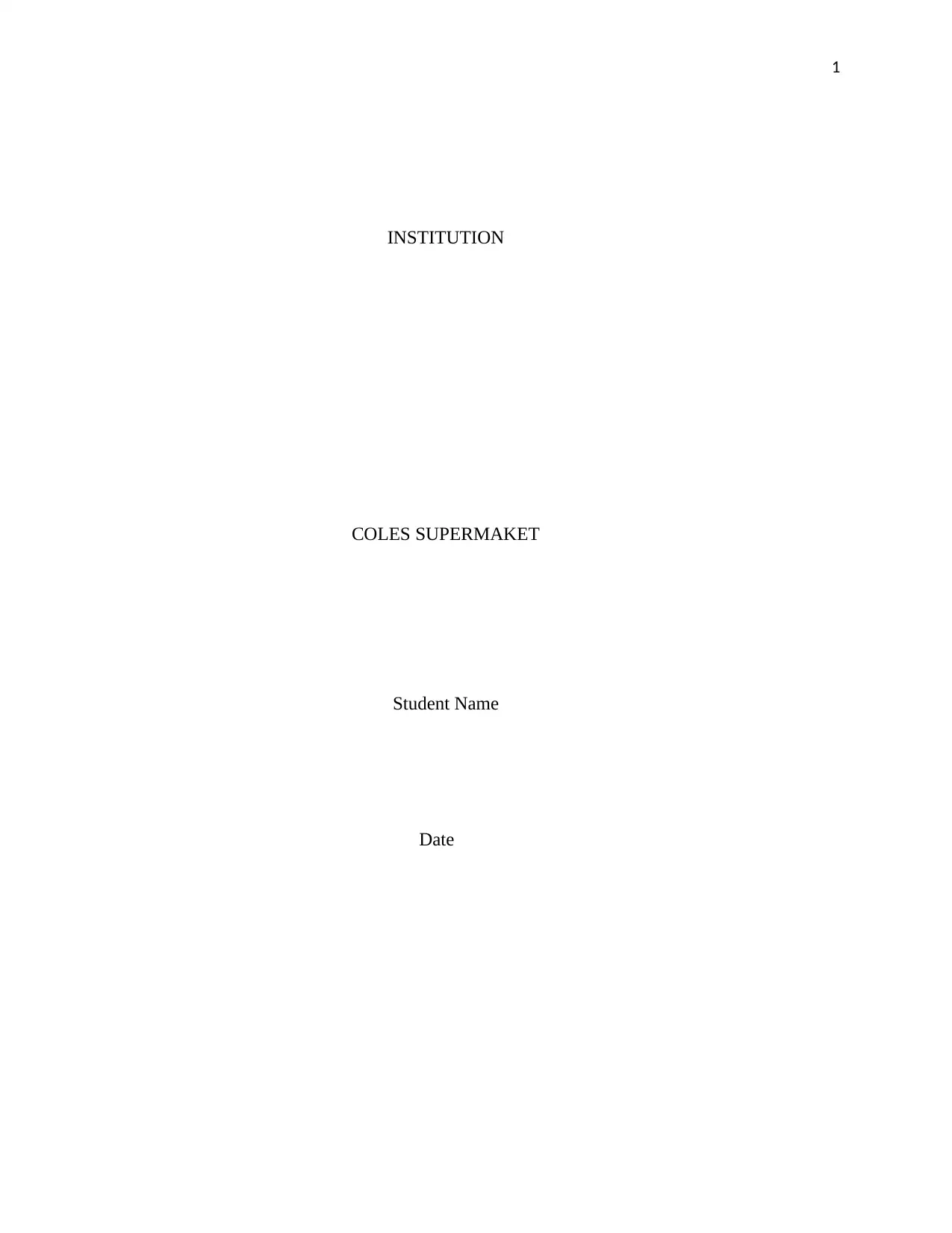
1
INSTITUTION
COLES SUPERMAKET
Student Name
Date
INSTITUTION
COLES SUPERMAKET
Student Name
Date
Paraphrase This Document
Need a fresh take? Get an instant paraphrase of this document with our AI Paraphraser

2
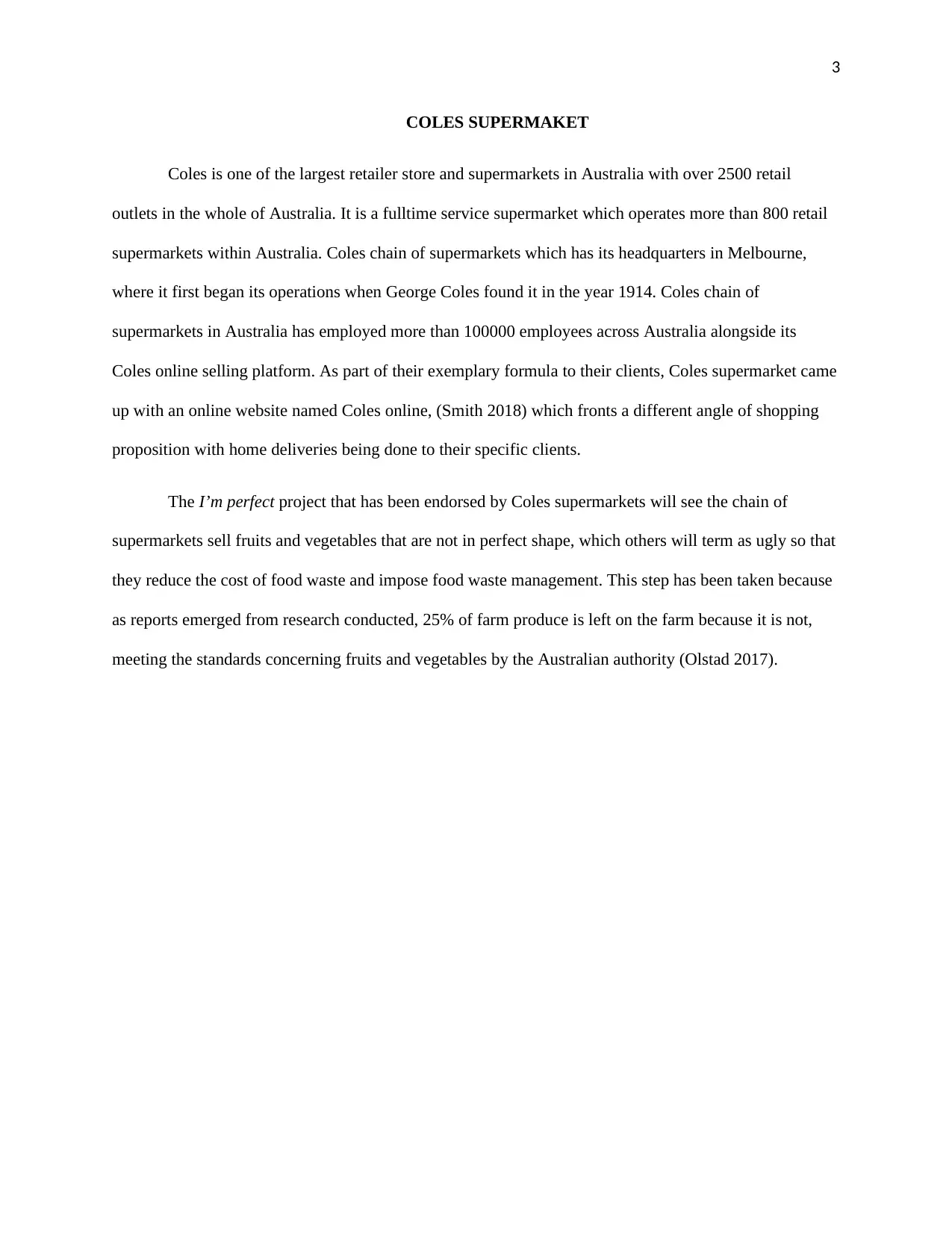
3
COLES SUPERMAKET
Coles is one of the largest retailer store and supermarkets in Australia with over 2500 retail
outlets in the whole of Australia. It is a fulltime service supermarket which operates more than 800 retail
supermarkets within Australia. Coles chain of supermarkets which has its headquarters in Melbourne,
where it first began its operations when George Coles found it in the year 1914. Coles chain of
supermarkets in Australia has employed more than 100000 employees across Australia alongside its
Coles online selling platform. As part of their exemplary formula to their clients, Coles supermarket came
up with an online website named Coles online, (Smith 2018) which fronts a different angle of shopping
proposition with home deliveries being done to their specific clients.
The I’m perfect project that has been endorsed by Coles supermarkets will see the chain of
supermarkets sell fruits and vegetables that are not in perfect shape, which others will term as ugly so that
they reduce the cost of food waste and impose food waste management. This step has been taken because
as reports emerged from research conducted, 25% of farm produce is left on the farm because it is not,
meeting the standards concerning fruits and vegetables by the Australian authority (Olstad 2017).
COLES SUPERMAKET
Coles is one of the largest retailer store and supermarkets in Australia with over 2500 retail
outlets in the whole of Australia. It is a fulltime service supermarket which operates more than 800 retail
supermarkets within Australia. Coles chain of supermarkets which has its headquarters in Melbourne,
where it first began its operations when George Coles found it in the year 1914. Coles chain of
supermarkets in Australia has employed more than 100000 employees across Australia alongside its
Coles online selling platform. As part of their exemplary formula to their clients, Coles supermarket came
up with an online website named Coles online, (Smith 2018) which fronts a different angle of shopping
proposition with home deliveries being done to their specific clients.
The I’m perfect project that has been endorsed by Coles supermarkets will see the chain of
supermarkets sell fruits and vegetables that are not in perfect shape, which others will term as ugly so that
they reduce the cost of food waste and impose food waste management. This step has been taken because
as reports emerged from research conducted, 25% of farm produce is left on the farm because it is not,
meeting the standards concerning fruits and vegetables by the Australian authority (Olstad 2017).
⊘ This is a preview!⊘
Do you want full access?
Subscribe today to unlock all pages.

Trusted by 1+ million students worldwide
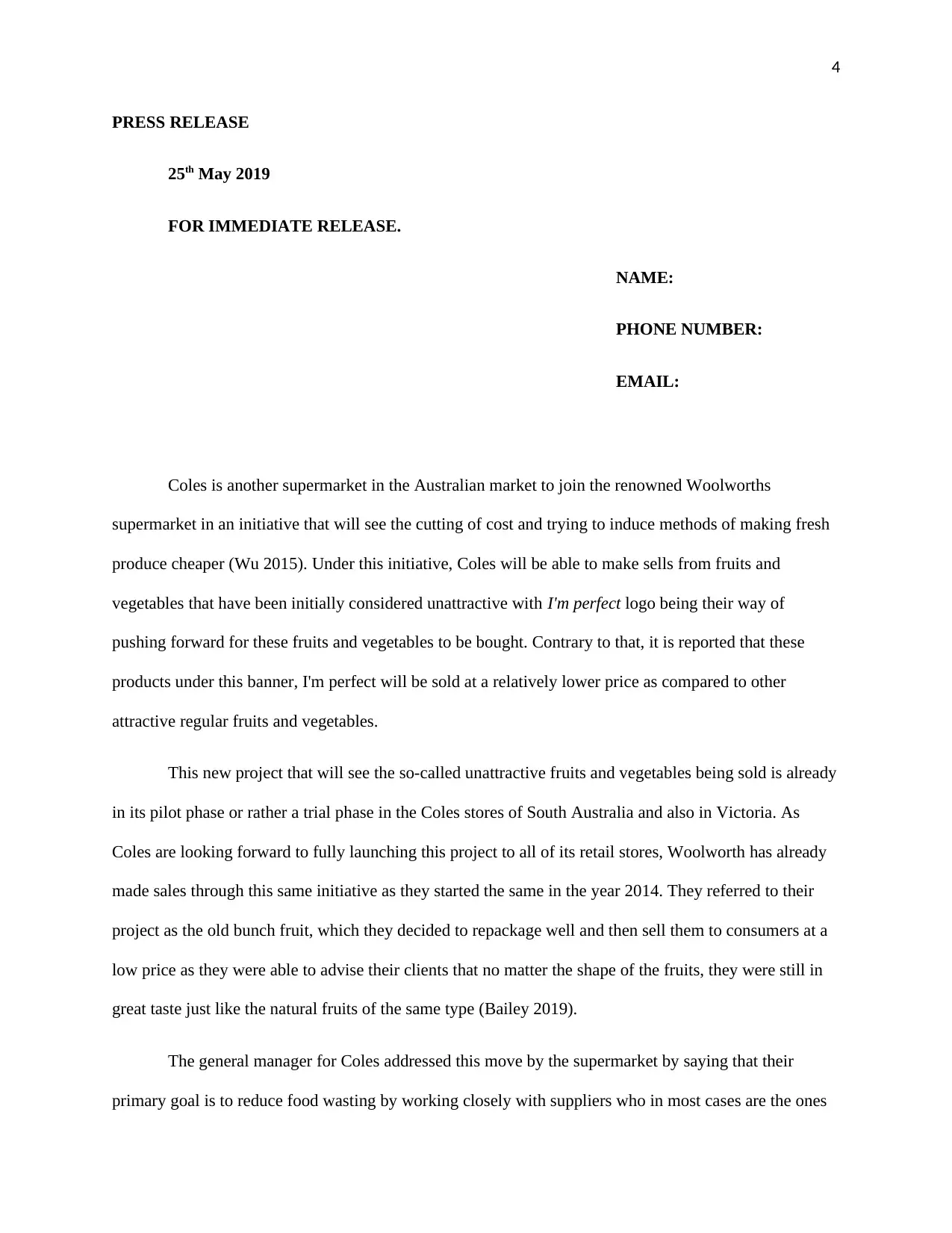
4
PRESS RELEASE
25th May 2019
FOR IMMEDIATE RELEASE.
NAME:
PHONE NUMBER:
EMAIL:
Coles is another supermarket in the Australian market to join the renowned Woolworths
supermarket in an initiative that will see the cutting of cost and trying to induce methods of making fresh
produce cheaper (Wu 2015). Under this initiative, Coles will be able to make sells from fruits and
vegetables that have been initially considered unattractive with I'm perfect logo being their way of
pushing forward for these fruits and vegetables to be bought. Contrary to that, it is reported that these
products under this banner, I'm perfect will be sold at a relatively lower price as compared to other
attractive regular fruits and vegetables.
This new project that will see the so-called unattractive fruits and vegetables being sold is already
in its pilot phase or rather a trial phase in the Coles stores of South Australia and also in Victoria. As
Coles are looking forward to fully launching this project to all of its retail stores, Woolworth has already
made sales through this same initiative as they started the same in the year 2014. They referred to their
project as the old bunch fruit, which they decided to repackage well and then sell them to consumers at a
low price as they were able to advise their clients that no matter the shape of the fruits, they were still in
great taste just like the natural fruits of the same type (Bailey 2019).
The general manager for Coles addressed this move by the supermarket by saying that their
primary goal is to reduce food wasting by working closely with suppliers who in most cases are the ones
PRESS RELEASE
25th May 2019
FOR IMMEDIATE RELEASE.
NAME:
PHONE NUMBER:
EMAIL:
Coles is another supermarket in the Australian market to join the renowned Woolworths
supermarket in an initiative that will see the cutting of cost and trying to induce methods of making fresh
produce cheaper (Wu 2015). Under this initiative, Coles will be able to make sells from fruits and
vegetables that have been initially considered unattractive with I'm perfect logo being their way of
pushing forward for these fruits and vegetables to be bought. Contrary to that, it is reported that these
products under this banner, I'm perfect will be sold at a relatively lower price as compared to other
attractive regular fruits and vegetables.
This new project that will see the so-called unattractive fruits and vegetables being sold is already
in its pilot phase or rather a trial phase in the Coles stores of South Australia and also in Victoria. As
Coles are looking forward to fully launching this project to all of its retail stores, Woolworth has already
made sales through this same initiative as they started the same in the year 2014. They referred to their
project as the old bunch fruit, which they decided to repackage well and then sell them to consumers at a
low price as they were able to advise their clients that no matter the shape of the fruits, they were still in
great taste just like the natural fruits of the same type (Bailey 2019).
The general manager for Coles addressed this move by the supermarket by saying that their
primary goal is to reduce food wasting by working closely with suppliers who in most cases are the ones
Paraphrase This Document
Need a fresh take? Get an instant paraphrase of this document with our AI Paraphraser
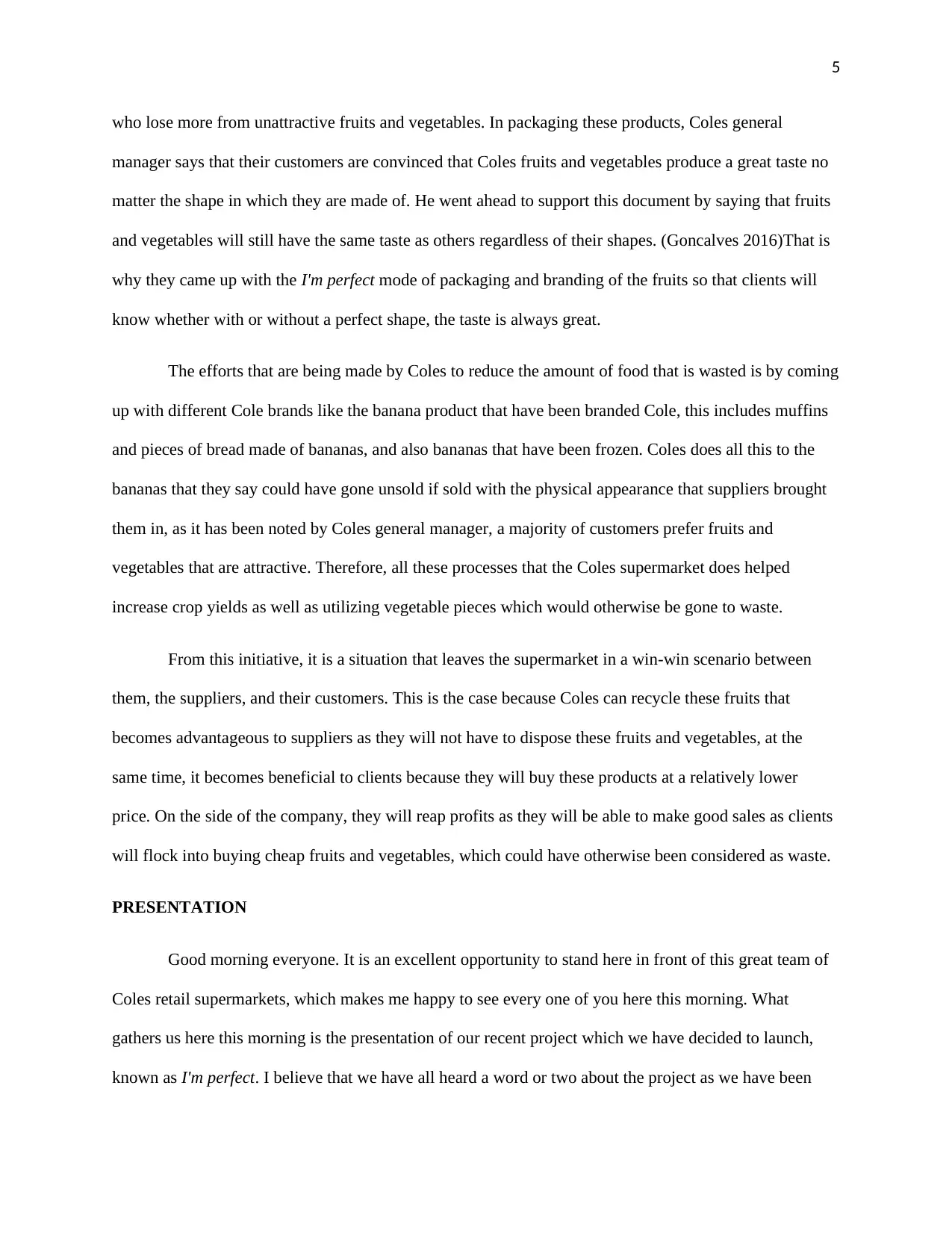
5
who lose more from unattractive fruits and vegetables. In packaging these products, Coles general
manager says that their customers are convinced that Coles fruits and vegetables produce a great taste no
matter the shape in which they are made of. He went ahead to support this document by saying that fruits
and vegetables will still have the same taste as others regardless of their shapes. (Goncalves 2016)That is
why they came up with the I'm perfect mode of packaging and branding of the fruits so that clients will
know whether with or without a perfect shape, the taste is always great.
The efforts that are being made by Coles to reduce the amount of food that is wasted is by coming
up with different Cole brands like the banana product that have been branded Cole, this includes muffins
and pieces of bread made of bananas, and also bananas that have been frozen. Coles does all this to the
bananas that they say could have gone unsold if sold with the physical appearance that suppliers brought
them in, as it has been noted by Coles general manager, a majority of customers prefer fruits and
vegetables that are attractive. Therefore, all these processes that the Coles supermarket does helped
increase crop yields as well as utilizing vegetable pieces which would otherwise be gone to waste.
From this initiative, it is a situation that leaves the supermarket in a win-win scenario between
them, the suppliers, and their customers. This is the case because Coles can recycle these fruits that
becomes advantageous to suppliers as they will not have to dispose these fruits and vegetables, at the
same time, it becomes beneficial to clients because they will buy these products at a relatively lower
price. On the side of the company, they will reap profits as they will be able to make good sales as clients
will flock into buying cheap fruits and vegetables, which could have otherwise been considered as waste.
PRESENTATION
Good morning everyone. It is an excellent opportunity to stand here in front of this great team of
Coles retail supermarkets, which makes me happy to see every one of you here this morning. What
gathers us here this morning is the presentation of our recent project which we have decided to launch,
known as I'm perfect. I believe that we have all heard a word or two about the project as we have been
who lose more from unattractive fruits and vegetables. In packaging these products, Coles general
manager says that their customers are convinced that Coles fruits and vegetables produce a great taste no
matter the shape in which they are made of. He went ahead to support this document by saying that fruits
and vegetables will still have the same taste as others regardless of their shapes. (Goncalves 2016)That is
why they came up with the I'm perfect mode of packaging and branding of the fruits so that clients will
know whether with or without a perfect shape, the taste is always great.
The efforts that are being made by Coles to reduce the amount of food that is wasted is by coming
up with different Cole brands like the banana product that have been branded Cole, this includes muffins
and pieces of bread made of bananas, and also bananas that have been frozen. Coles does all this to the
bananas that they say could have gone unsold if sold with the physical appearance that suppliers brought
them in, as it has been noted by Coles general manager, a majority of customers prefer fruits and
vegetables that are attractive. Therefore, all these processes that the Coles supermarket does helped
increase crop yields as well as utilizing vegetable pieces which would otherwise be gone to waste.
From this initiative, it is a situation that leaves the supermarket in a win-win scenario between
them, the suppliers, and their customers. This is the case because Coles can recycle these fruits that
becomes advantageous to suppliers as they will not have to dispose these fruits and vegetables, at the
same time, it becomes beneficial to clients because they will buy these products at a relatively lower
price. On the side of the company, they will reap profits as they will be able to make good sales as clients
will flock into buying cheap fruits and vegetables, which could have otherwise been considered as waste.
PRESENTATION
Good morning everyone. It is an excellent opportunity to stand here in front of this great team of
Coles retail supermarkets, which makes me happy to see every one of you here this morning. What
gathers us here this morning is the presentation of our recent project which we have decided to launch,
known as I'm perfect. I believe that we have all heard a word or two about the project as we have been
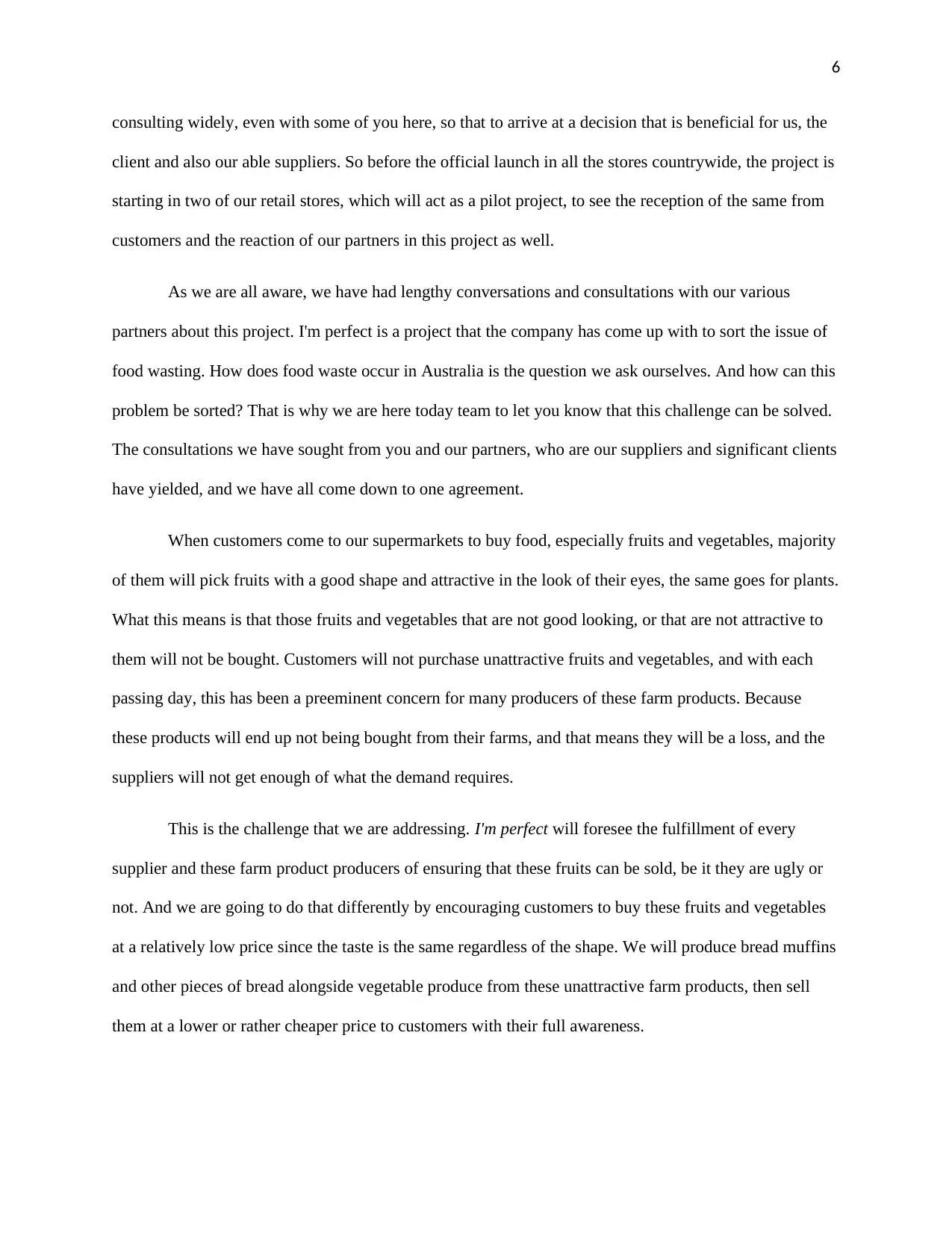
6
consulting widely, even with some of you here, so that to arrive at a decision that is beneficial for us, the
client and also our able suppliers. So before the official launch in all the stores countrywide, the project is
starting in two of our retail stores, which will act as a pilot project, to see the reception of the same from
customers and the reaction of our partners in this project as well.
As we are all aware, we have had lengthy conversations and consultations with our various
partners about this project. I'm perfect is a project that the company has come up with to sort the issue of
food wasting. How does food waste occur in Australia is the question we ask ourselves. And how can this
problem be sorted? That is why we are here today team to let you know that this challenge can be solved.
The consultations we have sought from you and our partners, who are our suppliers and significant clients
have yielded, and we have all come down to one agreement.
When customers come to our supermarkets to buy food, especially fruits and vegetables, majority
of them will pick fruits with a good shape and attractive in the look of their eyes, the same goes for plants.
What this means is that those fruits and vegetables that are not good looking, or that are not attractive to
them will not be bought. Customers will not purchase unattractive fruits and vegetables, and with each
passing day, this has been a preeminent concern for many producers of these farm products. Because
these products will end up not being bought from their farms, and that means they will be a loss, and the
suppliers will not get enough of what the demand requires.
This is the challenge that we are addressing. I'm perfect will foresee the fulfillment of every
supplier and these farm product producers of ensuring that these fruits can be sold, be it they are ugly or
not. And we are going to do that differently by encouraging customers to buy these fruits and vegetables
at a relatively low price since the taste is the same regardless of the shape. We will produce bread muffins
and other pieces of bread alongside vegetable produce from these unattractive farm products, then sell
them at a lower or rather cheaper price to customers with their full awareness.
consulting widely, even with some of you here, so that to arrive at a decision that is beneficial for us, the
client and also our able suppliers. So before the official launch in all the stores countrywide, the project is
starting in two of our retail stores, which will act as a pilot project, to see the reception of the same from
customers and the reaction of our partners in this project as well.
As we are all aware, we have had lengthy conversations and consultations with our various
partners about this project. I'm perfect is a project that the company has come up with to sort the issue of
food wasting. How does food waste occur in Australia is the question we ask ourselves. And how can this
problem be sorted? That is why we are here today team to let you know that this challenge can be solved.
The consultations we have sought from you and our partners, who are our suppliers and significant clients
have yielded, and we have all come down to one agreement.
When customers come to our supermarkets to buy food, especially fruits and vegetables, majority
of them will pick fruits with a good shape and attractive in the look of their eyes, the same goes for plants.
What this means is that those fruits and vegetables that are not good looking, or that are not attractive to
them will not be bought. Customers will not purchase unattractive fruits and vegetables, and with each
passing day, this has been a preeminent concern for many producers of these farm products. Because
these products will end up not being bought from their farms, and that means they will be a loss, and the
suppliers will not get enough of what the demand requires.
This is the challenge that we are addressing. I'm perfect will foresee the fulfillment of every
supplier and these farm product producers of ensuring that these fruits can be sold, be it they are ugly or
not. And we are going to do that differently by encouraging customers to buy these fruits and vegetables
at a relatively low price since the taste is the same regardless of the shape. We will produce bread muffins
and other pieces of bread alongside vegetable produce from these unattractive farm products, then sell
them at a lower or rather cheaper price to customers with their full awareness.
⊘ This is a preview!⊘
Do you want full access?
Subscribe today to unlock all pages.

Trusted by 1+ million students worldwide
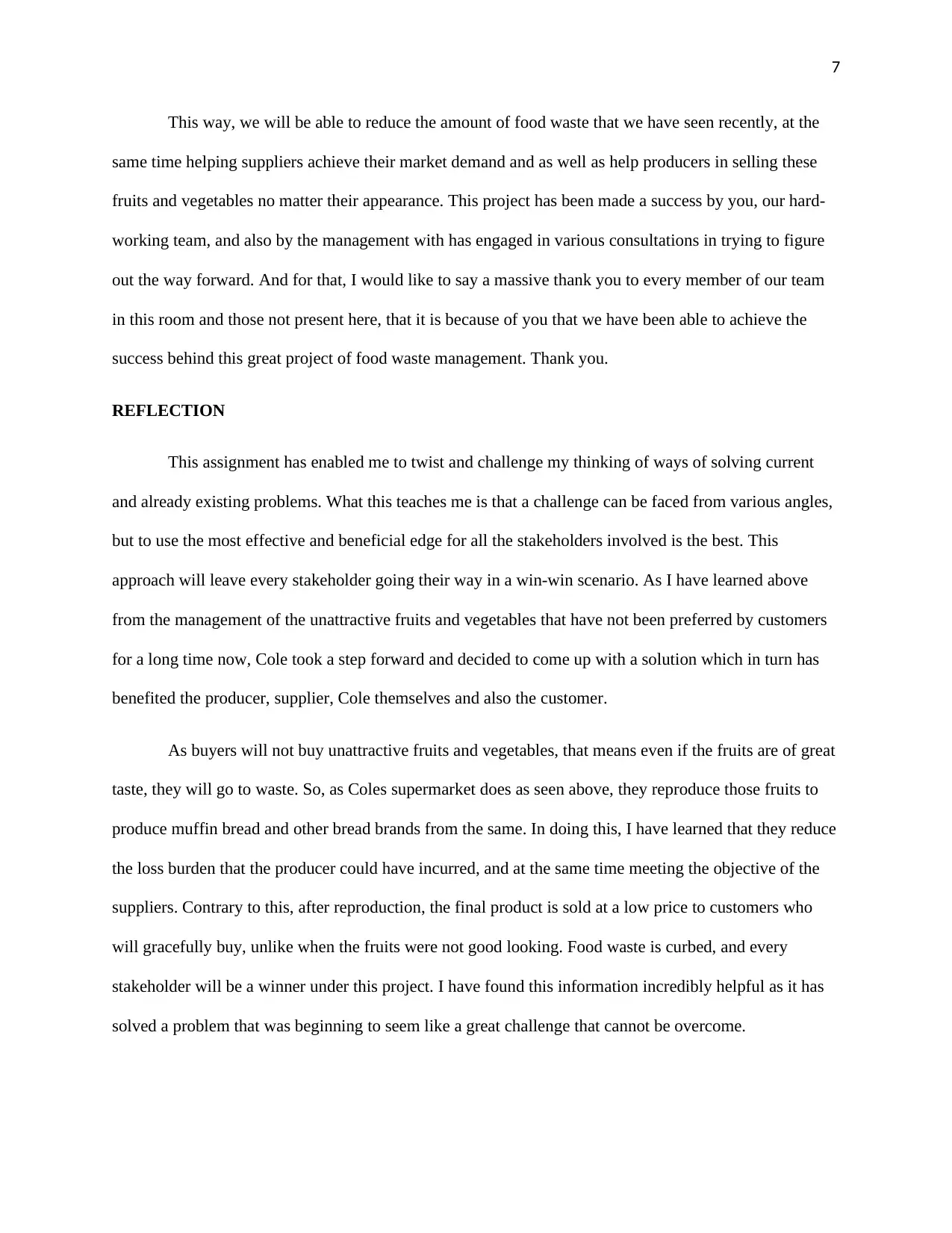
7
This way, we will be able to reduce the amount of food waste that we have seen recently, at the
same time helping suppliers achieve their market demand and as well as help producers in selling these
fruits and vegetables no matter their appearance. This project has been made a success by you, our hard-
working team, and also by the management with has engaged in various consultations in trying to figure
out the way forward. And for that, I would like to say a massive thank you to every member of our team
in this room and those not present here, that it is because of you that we have been able to achieve the
success behind this great project of food waste management. Thank you.
REFLECTION
This assignment has enabled me to twist and challenge my thinking of ways of solving current
and already existing problems. What this teaches me is that a challenge can be faced from various angles,
but to use the most effective and beneficial edge for all the stakeholders involved is the best. This
approach will leave every stakeholder going their way in a win-win scenario. As I have learned above
from the management of the unattractive fruits and vegetables that have not been preferred by customers
for a long time now, Cole took a step forward and decided to come up with a solution which in turn has
benefited the producer, supplier, Cole themselves and also the customer.
As buyers will not buy unattractive fruits and vegetables, that means even if the fruits are of great
taste, they will go to waste. So, as Coles supermarket does as seen above, they reproduce those fruits to
produce muffin bread and other bread brands from the same. In doing this, I have learned that they reduce
the loss burden that the producer could have incurred, and at the same time meeting the objective of the
suppliers. Contrary to this, after reproduction, the final product is sold at a low price to customers who
will gracefully buy, unlike when the fruits were not good looking. Food waste is curbed, and every
stakeholder will be a winner under this project. I have found this information incredibly helpful as it has
solved a problem that was beginning to seem like a great challenge that cannot be overcome.
This way, we will be able to reduce the amount of food waste that we have seen recently, at the
same time helping suppliers achieve their market demand and as well as help producers in selling these
fruits and vegetables no matter their appearance. This project has been made a success by you, our hard-
working team, and also by the management with has engaged in various consultations in trying to figure
out the way forward. And for that, I would like to say a massive thank you to every member of our team
in this room and those not present here, that it is because of you that we have been able to achieve the
success behind this great project of food waste management. Thank you.
REFLECTION
This assignment has enabled me to twist and challenge my thinking of ways of solving current
and already existing problems. What this teaches me is that a challenge can be faced from various angles,
but to use the most effective and beneficial edge for all the stakeholders involved is the best. This
approach will leave every stakeholder going their way in a win-win scenario. As I have learned above
from the management of the unattractive fruits and vegetables that have not been preferred by customers
for a long time now, Cole took a step forward and decided to come up with a solution which in turn has
benefited the producer, supplier, Cole themselves and also the customer.
As buyers will not buy unattractive fruits and vegetables, that means even if the fruits are of great
taste, they will go to waste. So, as Coles supermarket does as seen above, they reproduce those fruits to
produce muffin bread and other bread brands from the same. In doing this, I have learned that they reduce
the loss burden that the producer could have incurred, and at the same time meeting the objective of the
suppliers. Contrary to this, after reproduction, the final product is sold at a low price to customers who
will gracefully buy, unlike when the fruits were not good looking. Food waste is curbed, and every
stakeholder will be a winner under this project. I have found this information incredibly helpful as it has
solved a problem that was beginning to seem like a great challenge that cannot be overcome.
Paraphrase This Document
Need a fresh take? Get an instant paraphrase of this document with our AI Paraphraser
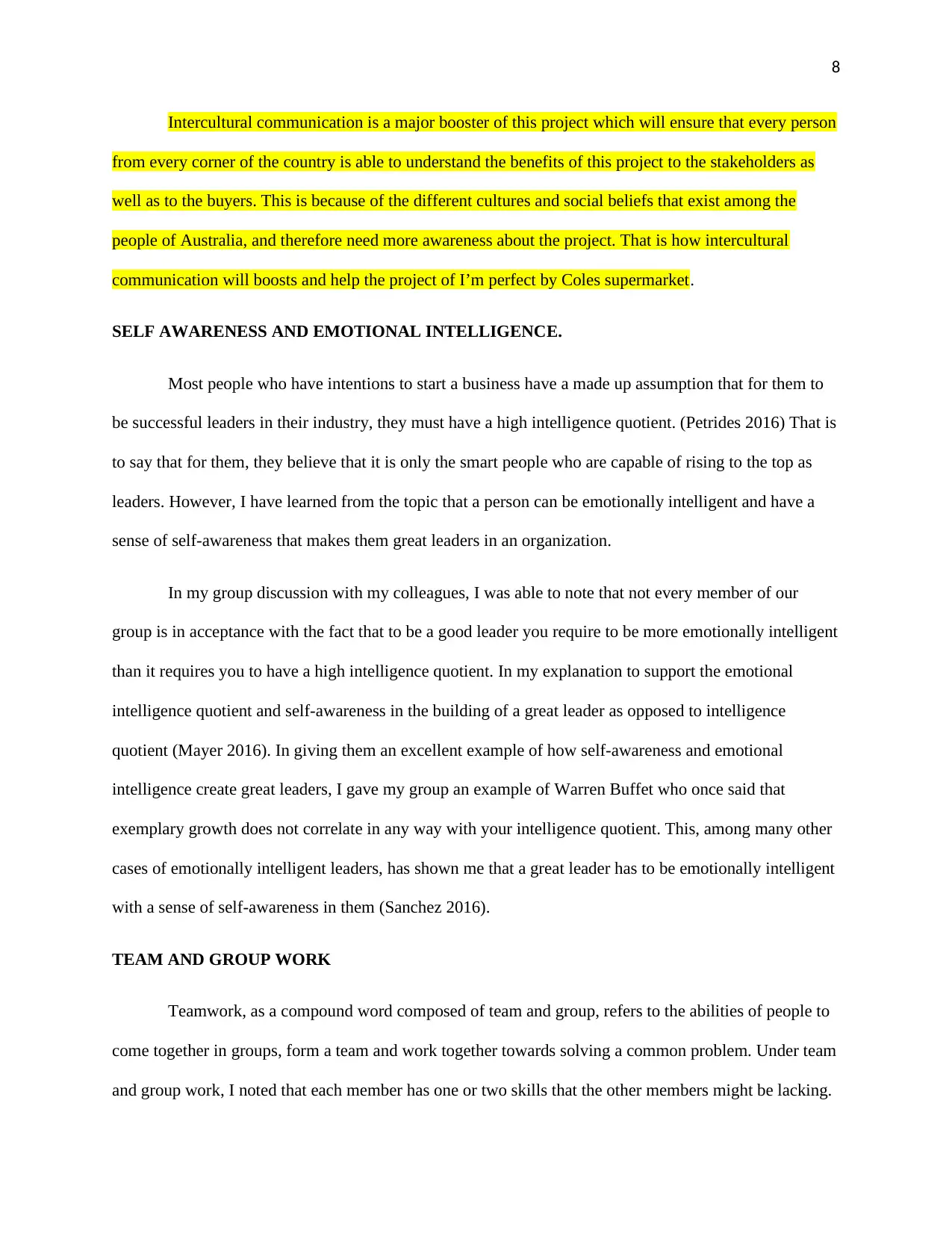
8
Intercultural communication is a major booster of this project which will ensure that every person
from every corner of the country is able to understand the benefits of this project to the stakeholders as
well as to the buyers. This is because of the different cultures and social beliefs that exist among the
people of Australia, and therefore need more awareness about the project. That is how intercultural
communication will boosts and help the project of I’m perfect by Coles supermarket.
SELF AWARENESS AND EMOTIONAL INTELLIGENCE.
Most people who have intentions to start a business have a made up assumption that for them to
be successful leaders in their industry, they must have a high intelligence quotient. (Petrides 2016) That is
to say that for them, they believe that it is only the smart people who are capable of rising to the top as
leaders. However, I have learned from the topic that a person can be emotionally intelligent and have a
sense of self-awareness that makes them great leaders in an organization.
In my group discussion with my colleagues, I was able to note that not every member of our
group is in acceptance with the fact that to be a good leader you require to be more emotionally intelligent
than it requires you to have a high intelligence quotient. In my explanation to support the emotional
intelligence quotient and self-awareness in the building of a great leader as opposed to intelligence
quotient (Mayer 2016). In giving them an excellent example of how self-awareness and emotional
intelligence create great leaders, I gave my group an example of Warren Buffet who once said that
exemplary growth does not correlate in any way with your intelligence quotient. This, among many other
cases of emotionally intelligent leaders, has shown me that a great leader has to be emotionally intelligent
with a sense of self-awareness in them (Sanchez 2016).
TEAM AND GROUP WORK
Teamwork, as a compound word composed of team and group, refers to the abilities of people to
come together in groups, form a team and work together towards solving a common problem. Under team
and group work, I noted that each member has one or two skills that the other members might be lacking.
Intercultural communication is a major booster of this project which will ensure that every person
from every corner of the country is able to understand the benefits of this project to the stakeholders as
well as to the buyers. This is because of the different cultures and social beliefs that exist among the
people of Australia, and therefore need more awareness about the project. That is how intercultural
communication will boosts and help the project of I’m perfect by Coles supermarket.
SELF AWARENESS AND EMOTIONAL INTELLIGENCE.
Most people who have intentions to start a business have a made up assumption that for them to
be successful leaders in their industry, they must have a high intelligence quotient. (Petrides 2016) That is
to say that for them, they believe that it is only the smart people who are capable of rising to the top as
leaders. However, I have learned from the topic that a person can be emotionally intelligent and have a
sense of self-awareness that makes them great leaders in an organization.
In my group discussion with my colleagues, I was able to note that not every member of our
group is in acceptance with the fact that to be a good leader you require to be more emotionally intelligent
than it requires you to have a high intelligence quotient. In my explanation to support the emotional
intelligence quotient and self-awareness in the building of a great leader as opposed to intelligence
quotient (Mayer 2016). In giving them an excellent example of how self-awareness and emotional
intelligence create great leaders, I gave my group an example of Warren Buffet who once said that
exemplary growth does not correlate in any way with your intelligence quotient. This, among many other
cases of emotionally intelligent leaders, has shown me that a great leader has to be emotionally intelligent
with a sense of self-awareness in them (Sanchez 2016).
TEAM AND GROUP WORK
Teamwork, as a compound word composed of team and group, refers to the abilities of people to
come together in groups, form a team and work together towards solving a common problem. Under team
and group work, I noted that each member has one or two skills that the other members might be lacking.
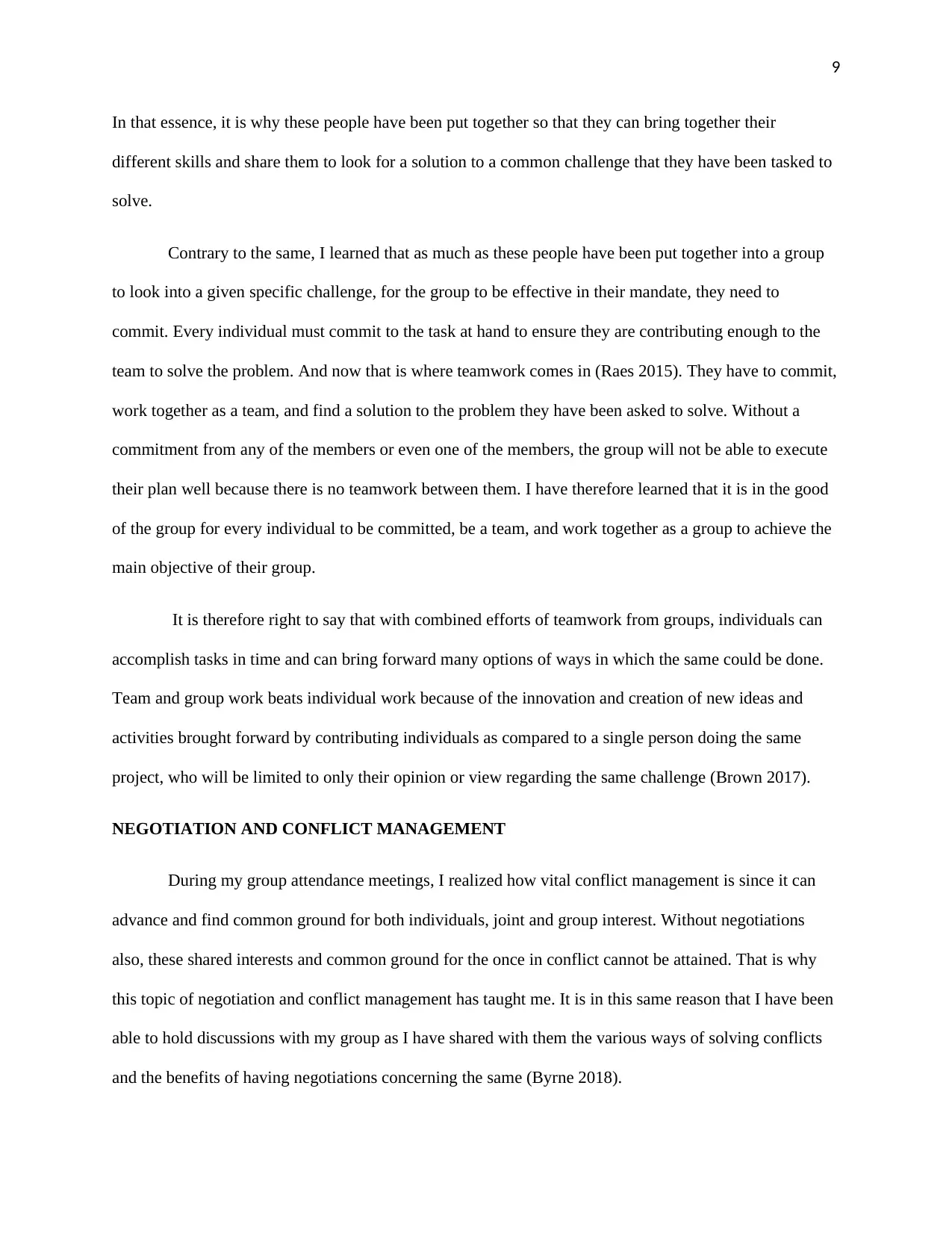
9
In that essence, it is why these people have been put together so that they can bring together their
different skills and share them to look for a solution to a common challenge that they have been tasked to
solve.
Contrary to the same, I learned that as much as these people have been put together into a group
to look into a given specific challenge, for the group to be effective in their mandate, they need to
commit. Every individual must commit to the task at hand to ensure they are contributing enough to the
team to solve the problem. And now that is where teamwork comes in (Raes 2015). They have to commit,
work together as a team, and find a solution to the problem they have been asked to solve. Without a
commitment from any of the members or even one of the members, the group will not be able to execute
their plan well because there is no teamwork between them. I have therefore learned that it is in the good
of the group for every individual to be committed, be a team, and work together as a group to achieve the
main objective of their group.
It is therefore right to say that with combined efforts of teamwork from groups, individuals can
accomplish tasks in time and can bring forward many options of ways in which the same could be done.
Team and group work beats individual work because of the innovation and creation of new ideas and
activities brought forward by contributing individuals as compared to a single person doing the same
project, who will be limited to only their opinion or view regarding the same challenge (Brown 2017).
NEGOTIATION AND CONFLICT MANAGEMENT
During my group attendance meetings, I realized how vital conflict management is since it can
advance and find common ground for both individuals, joint and group interest. Without negotiations
also, these shared interests and common ground for the once in conflict cannot be attained. That is why
this topic of negotiation and conflict management has taught me. It is in this same reason that I have been
able to hold discussions with my group as I have shared with them the various ways of solving conflicts
and the benefits of having negotiations concerning the same (Byrne 2018).
In that essence, it is why these people have been put together so that they can bring together their
different skills and share them to look for a solution to a common challenge that they have been tasked to
solve.
Contrary to the same, I learned that as much as these people have been put together into a group
to look into a given specific challenge, for the group to be effective in their mandate, they need to
commit. Every individual must commit to the task at hand to ensure they are contributing enough to the
team to solve the problem. And now that is where teamwork comes in (Raes 2015). They have to commit,
work together as a team, and find a solution to the problem they have been asked to solve. Without a
commitment from any of the members or even one of the members, the group will not be able to execute
their plan well because there is no teamwork between them. I have therefore learned that it is in the good
of the group for every individual to be committed, be a team, and work together as a group to achieve the
main objective of their group.
It is therefore right to say that with combined efforts of teamwork from groups, individuals can
accomplish tasks in time and can bring forward many options of ways in which the same could be done.
Team and group work beats individual work because of the innovation and creation of new ideas and
activities brought forward by contributing individuals as compared to a single person doing the same
project, who will be limited to only their opinion or view regarding the same challenge (Brown 2017).
NEGOTIATION AND CONFLICT MANAGEMENT
During my group attendance meetings, I realized how vital conflict management is since it can
advance and find common ground for both individuals, joint and group interest. Without negotiations
also, these shared interests and common ground for the once in conflict cannot be attained. That is why
this topic of negotiation and conflict management has taught me. It is in this same reason that I have been
able to hold discussions with my group as I have shared with them the various ways of solving conflicts
and the benefits of having negotiations concerning the same (Byrne 2018).
⊘ This is a preview!⊘
Do you want full access?
Subscribe today to unlock all pages.

Trusted by 1+ million students worldwide
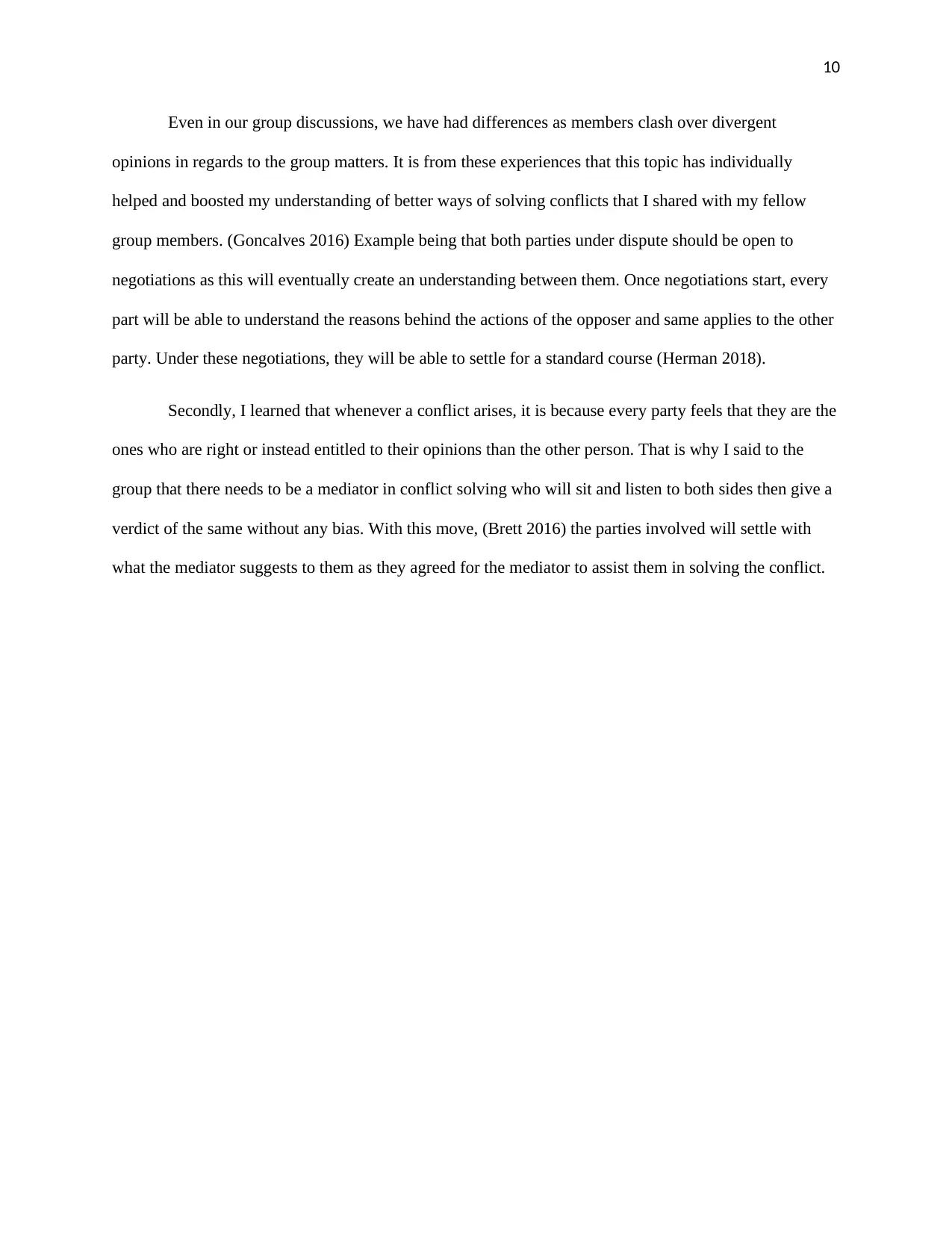
10
Even in our group discussions, we have had differences as members clash over divergent
opinions in regards to the group matters. It is from these experiences that this topic has individually
helped and boosted my understanding of better ways of solving conflicts that I shared with my fellow
group members. (Goncalves 2016) Example being that both parties under dispute should be open to
negotiations as this will eventually create an understanding between them. Once negotiations start, every
part will be able to understand the reasons behind the actions of the opposer and same applies to the other
party. Under these negotiations, they will be able to settle for a standard course (Herman 2018).
Secondly, I learned that whenever a conflict arises, it is because every party feels that they are the
ones who are right or instead entitled to their opinions than the other person. That is why I said to the
group that there needs to be a mediator in conflict solving who will sit and listen to both sides then give a
verdict of the same without any bias. With this move, (Brett 2016) the parties involved will settle with
what the mediator suggests to them as they agreed for the mediator to assist them in solving the conflict.
Even in our group discussions, we have had differences as members clash over divergent
opinions in regards to the group matters. It is from these experiences that this topic has individually
helped and boosted my understanding of better ways of solving conflicts that I shared with my fellow
group members. (Goncalves 2016) Example being that both parties under dispute should be open to
negotiations as this will eventually create an understanding between them. Once negotiations start, every
part will be able to understand the reasons behind the actions of the opposer and same applies to the other
party. Under these negotiations, they will be able to settle for a standard course (Herman 2018).
Secondly, I learned that whenever a conflict arises, it is because every party feels that they are the
ones who are right or instead entitled to their opinions than the other person. That is why I said to the
group that there needs to be a mediator in conflict solving who will sit and listen to both sides then give a
verdict of the same without any bias. With this move, (Brett 2016) the parties involved will settle with
what the mediator suggests to them as they agreed for the mediator to assist them in solving the conflict.
Paraphrase This Document
Need a fresh take? Get an instant paraphrase of this document with our AI Paraphraser
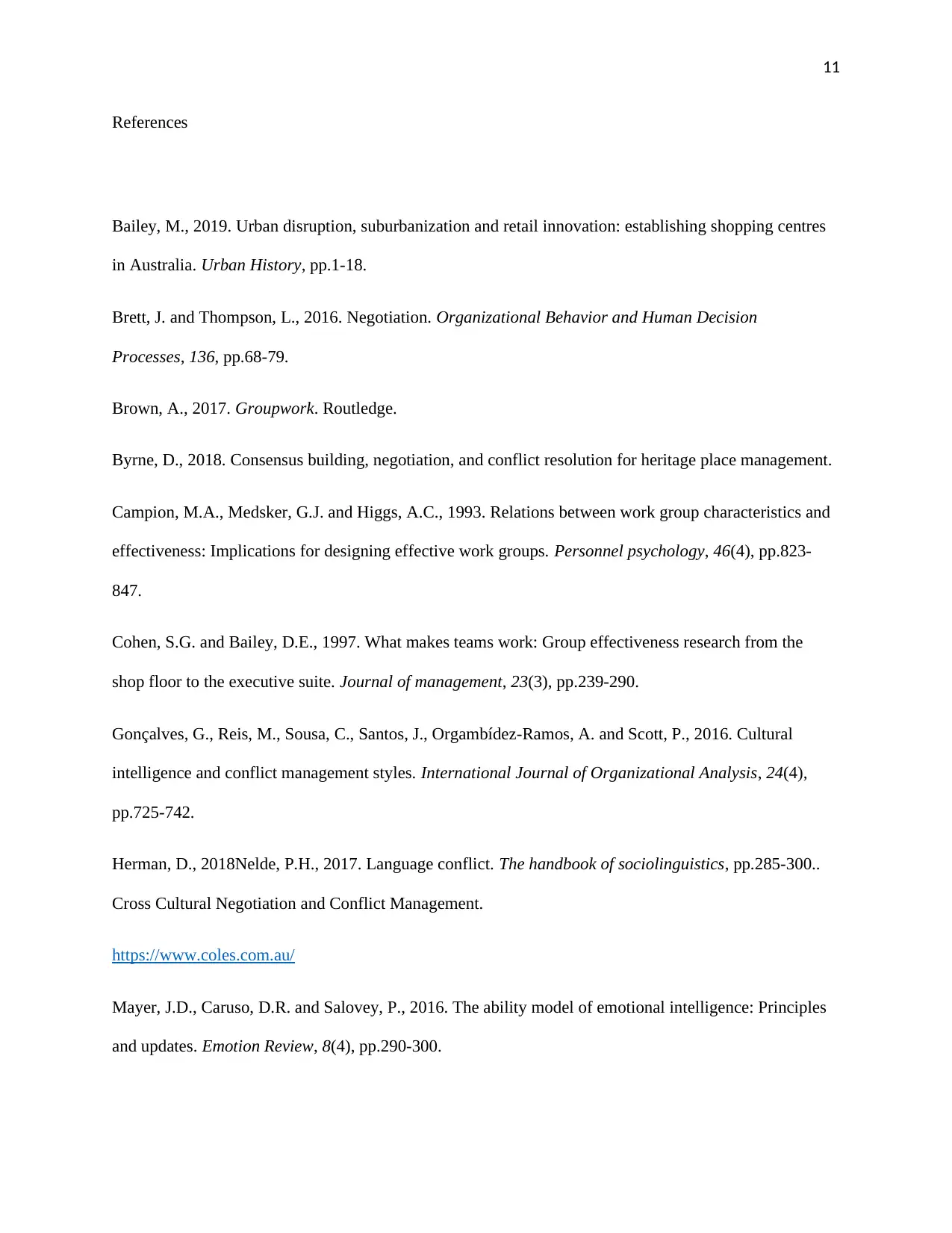
11
References
Bailey, M., 2019. Urban disruption, suburbanization and retail innovation: establishing shopping centres
in Australia. Urban History, pp.1-18.
Brett, J. and Thompson, L., 2016. Negotiation. Organizational Behavior and Human Decision
Processes, 136, pp.68-79.
Brown, A., 2017. Groupwork. Routledge.
Byrne, D., 2018. Consensus building, negotiation, and conflict resolution for heritage place management.
Campion, M.A., Medsker, G.J. and Higgs, A.C., 1993. Relations between work group characteristics and
effectiveness: Implications for designing effective work groups. Personnel psychology, 46(4), pp.823-
847.
Cohen, S.G. and Bailey, D.E., 1997. What makes teams work: Group effectiveness research from the
shop floor to the executive suite. Journal of management, 23(3), pp.239-290.
Gonçalves, G., Reis, M., Sousa, C., Santos, J., Orgambídez-Ramos, A. and Scott, P., 2016. Cultural
intelligence and conflict management styles. International Journal of Organizational Analysis, 24(4),
pp.725-742.
Herman, D., 2018Nelde, P.H., 2017. Language conflict. The handbook of sociolinguistics, pp.285-300..
Cross Cultural Negotiation and Conflict Management.
https://www.coles.com.au/
Mayer, J.D., Caruso, D.R. and Salovey, P., 2016. The ability model of emotional intelligence: Principles
and updates. Emotion Review, 8(4), pp.290-300.
References
Bailey, M., 2019. Urban disruption, suburbanization and retail innovation: establishing shopping centres
in Australia. Urban History, pp.1-18.
Brett, J. and Thompson, L., 2016. Negotiation. Organizational Behavior and Human Decision
Processes, 136, pp.68-79.
Brown, A., 2017. Groupwork. Routledge.
Byrne, D., 2018. Consensus building, negotiation, and conflict resolution for heritage place management.
Campion, M.A., Medsker, G.J. and Higgs, A.C., 1993. Relations between work group characteristics and
effectiveness: Implications for designing effective work groups. Personnel psychology, 46(4), pp.823-
847.
Cohen, S.G. and Bailey, D.E., 1997. What makes teams work: Group effectiveness research from the
shop floor to the executive suite. Journal of management, 23(3), pp.239-290.
Gonçalves, G., Reis, M., Sousa, C., Santos, J., Orgambídez-Ramos, A. and Scott, P., 2016. Cultural
intelligence and conflict management styles. International Journal of Organizational Analysis, 24(4),
pp.725-742.
Herman, D., 2018Nelde, P.H., 2017. Language conflict. The handbook of sociolinguistics, pp.285-300..
Cross Cultural Negotiation and Conflict Management.
https://www.coles.com.au/
Mayer, J.D., Caruso, D.R. and Salovey, P., 2016. The ability model of emotional intelligence: Principles
and updates. Emotion Review, 8(4), pp.290-300.
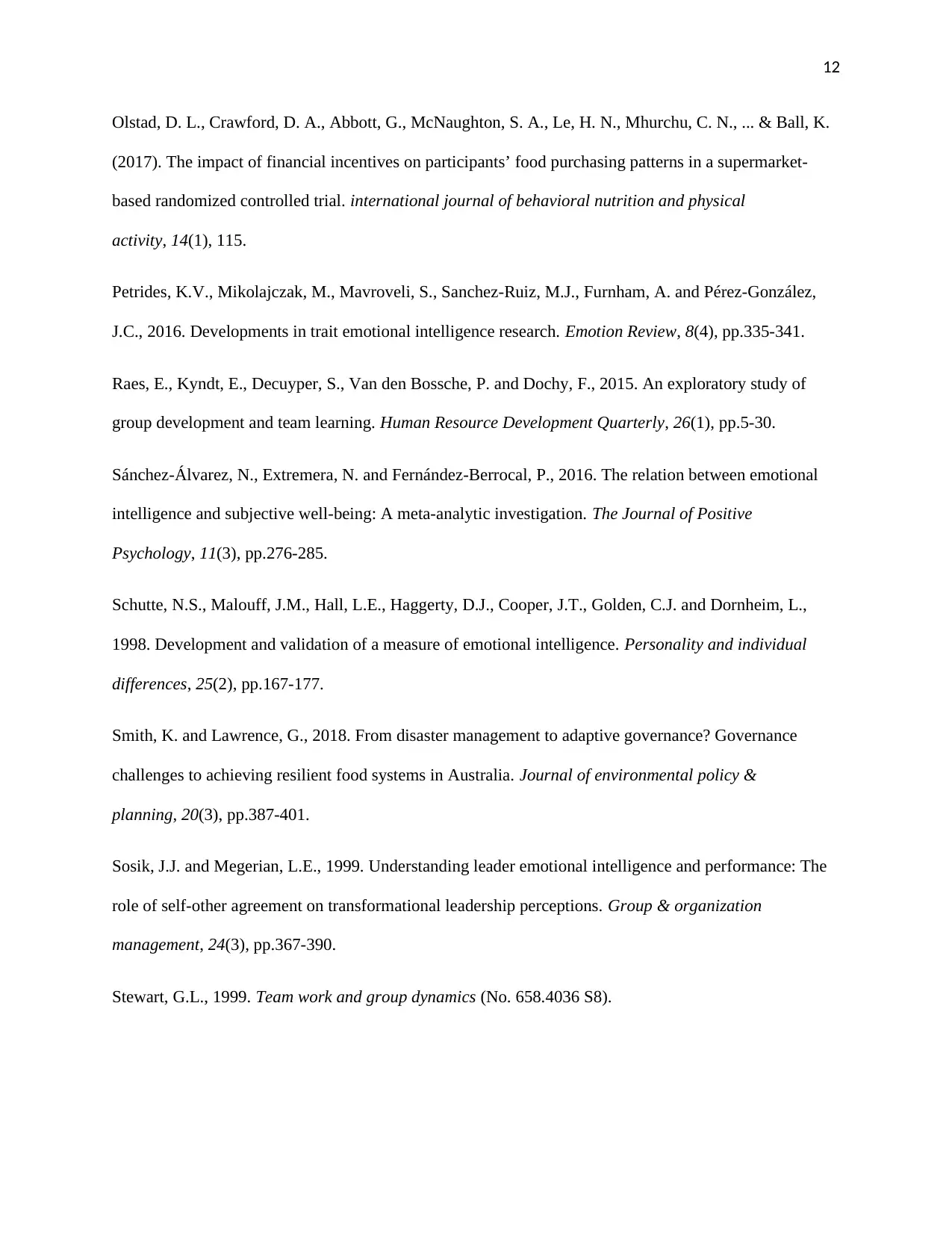
12
Olstad, D. L., Crawford, D. A., Abbott, G., McNaughton, S. A., Le, H. N., Mhurchu, C. N., ... & Ball, K.
(2017). The impact of financial incentives on participants’ food purchasing patterns in a supermarket-
based randomized controlled trial. international journal of behavioral nutrition and physical
activity, 14(1), 115.
Petrides, K.V., Mikolajczak, M., Mavroveli, S., Sanchez-Ruiz, M.J., Furnham, A. and Pérez-González,
J.C., 2016. Developments in trait emotional intelligence research. Emotion Review, 8(4), pp.335-341.
Raes, E., Kyndt, E., Decuyper, S., Van den Bossche, P. and Dochy, F., 2015. An exploratory study of
group development and team learning. Human Resource Development Quarterly, 26(1), pp.5-30.
Sánchez-Álvarez, N., Extremera, N. and Fernández-Berrocal, P., 2016. The relation between emotional
intelligence and subjective well-being: A meta-analytic investigation. The Journal of Positive
Psychology, 11(3), pp.276-285.
Schutte, N.S., Malouff, J.M., Hall, L.E., Haggerty, D.J., Cooper, J.T., Golden, C.J. and Dornheim, L.,
1998. Development and validation of a measure of emotional intelligence. Personality and individual
differences, 25(2), pp.167-177.
Smith, K. and Lawrence, G., 2018. From disaster management to adaptive governance? Governance
challenges to achieving resilient food systems in Australia. Journal of environmental policy &
planning, 20(3), pp.387-401.
Sosik, J.J. and Megerian, L.E., 1999. Understanding leader emotional intelligence and performance: The
role of self-other agreement on transformational leadership perceptions. Group & organization
management, 24(3), pp.367-390.
Stewart, G.L., 1999. Team work and group dynamics (No. 658.4036 S8).
Olstad, D. L., Crawford, D. A., Abbott, G., McNaughton, S. A., Le, H. N., Mhurchu, C. N., ... & Ball, K.
(2017). The impact of financial incentives on participants’ food purchasing patterns in a supermarket-
based randomized controlled trial. international journal of behavioral nutrition and physical
activity, 14(1), 115.
Petrides, K.V., Mikolajczak, M., Mavroveli, S., Sanchez-Ruiz, M.J., Furnham, A. and Pérez-González,
J.C., 2016. Developments in trait emotional intelligence research. Emotion Review, 8(4), pp.335-341.
Raes, E., Kyndt, E., Decuyper, S., Van den Bossche, P. and Dochy, F., 2015. An exploratory study of
group development and team learning. Human Resource Development Quarterly, 26(1), pp.5-30.
Sánchez-Álvarez, N., Extremera, N. and Fernández-Berrocal, P., 2016. The relation between emotional
intelligence and subjective well-being: A meta-analytic investigation. The Journal of Positive
Psychology, 11(3), pp.276-285.
Schutte, N.S., Malouff, J.M., Hall, L.E., Haggerty, D.J., Cooper, J.T., Golden, C.J. and Dornheim, L.,
1998. Development and validation of a measure of emotional intelligence. Personality and individual
differences, 25(2), pp.167-177.
Smith, K. and Lawrence, G., 2018. From disaster management to adaptive governance? Governance
challenges to achieving resilient food systems in Australia. Journal of environmental policy &
planning, 20(3), pp.387-401.
Sosik, J.J. and Megerian, L.E., 1999. Understanding leader emotional intelligence and performance: The
role of self-other agreement on transformational leadership perceptions. Group & organization
management, 24(3), pp.367-390.
Stewart, G.L., 1999. Team work and group dynamics (No. 658.4036 S8).
⊘ This is a preview!⊘
Do you want full access?
Subscribe today to unlock all pages.

Trusted by 1+ million students worldwide
1 out of 13
Related Documents
Your All-in-One AI-Powered Toolkit for Academic Success.
+13062052269
info@desklib.com
Available 24*7 on WhatsApp / Email
![[object Object]](/_next/static/media/star-bottom.7253800d.svg)
Unlock your academic potential
Copyright © 2020–2025 A2Z Services. All Rights Reserved. Developed and managed by ZUCOL.





